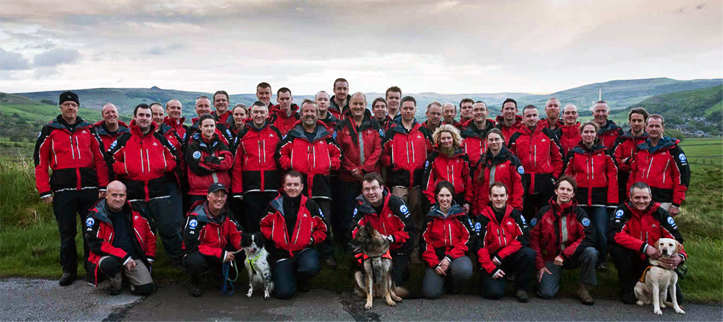
We are lucky to live on the edge of one of the most beautiful parts of the country. Many members who enjoy walking, biking or just motoring through the Peak District were familiar with the Edale Mountain Rescue team (EMRT) facility located at the foot of Stanage but knew less about its origins, activities and the expertise required to man the local arm of this vital national service.
Our (Stand-in) speaker this week, Andy Cass, had been a member of EMART for over 30 years. He divided his talk between outlining the Charity’s history locally and demonstrating samples of the wide range of always ready pre-packed equipment tailored for differing emergency situations and weather conditions.
EMART roots go back to the 1950s and the formation of the Peak District National Park. The increase in rights of way, signed footpaths and the motor car were to give easier access to often wild and remote country exposing the growing numbers of visitors to both its delights and dangers. In response, the Peak Park Planning Board and local rescue volunteers met in 1956 to establish the present organisation. In the early years equipment was kept in a damp hay loft at North Lees moving to the current site in 1986 owned by the then Blue Circle Cement Co. Various improvements have been made, graduating from two ex NHS portakabins to the present purpose built facility opened in 2007. This can securely house all the team’s modern equipment and 3 Land Rover ambulances.
EMART currently has 48 team members plus one dog. 15 members are qualified medics including junior doctors. They respond to an average 120 ‘call outs’ annually, mostly in North Derbyshire but occasionally further afield such as the Carlisle flood emergency, major motorway accidents and more than one crashed hang-glider. A reported air crash at Ladybower turned out to be a false alarm. In these they called upon to assist the Emergency Services. IN difficult cases the team can call on Helicopter assistance from East Midlands and Humberside Airports. About 60% of cases are dealing with traumatic injuries (especially falls from rock faces etc, fractures, cycling accidents), 25% are other medical conditions (inc Cardiac, hypothermia epileptic fits, diabetes incidents) and 15% missing persons. People are often found initially by the team dog having no map, compass, suitable clothing or footwear. Despite poor reception in some areas, the mobile phone has transformed team assembly, contact and hence speed and efficiency of response. On receiving a call, the rota team leader makes an assessment of the manpower, expertise and equipment required and alerts members who are often on scene within 30-40 minutes. Great emphasis is given to professionalism in the use of rescue and first equipment with frequent familiarisation and updating of expertise which is externally assessed. The team participates in civic emergency exercises such as a simulated crash in Totley railway tunnel. EMRT has an annual budget of £60000 but receives no Government finance. Some equipment, drugs and medical disposables are provided by the NHS.
Andy then moved on to show us some of the equipment used in the field. This is typically carried in rucksacks etc which can weight up to 15 Kilogrammes. An amazing array of goodies emerged, somehow squeezed into the bags: a radio handset, a location computer, various types of splint (both low and high tec) vacuum bags and pumps, a pulse reader, a defibrillator not mention various gas canisters, bandages, emergency rations and what looked like drug phials.
In conclusion, while such jaunts may now be a bit much for some of us, Andy gave us some tips on how to prepare and survive our next foray into the wild world beyond Ringinglow. These included:
- Get the forecast: If Snow on the Snake avoid Kinder! Always go prepared for the expected and unexpected weather: conditions can rapidly change. Take warm, visible waterproofs and footwear suitable for the terrain
- Take map and compass and learn how to use them including providing references. Put likely location area reference on your mobile. Give police mobile no before setting out
- If you need to guide a helicopter, wave a red coat, your back to the wind, hands raised in the ‘Y’ position. (Diagonal Arms for not required)
- Take Elastoplast, Mars Bars and drink.
This most interesting session drew to a close with a wide range of questions and observations. It was clear that many people owe a great debt of gratitude this this small band of volunteers who give of their time and expertise, turning out 24/7, no matter the weather. On such was a member who shared with us that he owed his life to the splendid folk who make up EMART. More information on the organisation can be found at www.edalemrt.co.uk.
